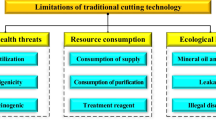Abstract
This study adopted nanosecond laser to conduct drilling research on nickel-based alloy with thermal barrier coatings (TBCs). The experiments of different processing environments on quality and efficiency of laser drilling were conducted. Through combination of high processing efficiency under air environment and good processing quality under water environment, temporal control of air/water environment on laser drilling is proposed. Since drilling efficiency was not significantly reduced, cold machining effect of water was used to improve processing quality. Research results proved that laser processing method with temporal control of air/water environment has advantages of traditional laser drilling under air and water. Laser drilling of temporal control of air/water environment was improved in quality in comparison with single environment.
Similar content being viewed by others
References
Guo YF, Zhang GW, Wang L, Hu YH (2016) Optimization of parameters for EDM drilling of thermal-barrier-coated nickel superalloys using gray relational analysis method. Int J Adv Manuf Technol 83:1595–1605
Zhang Y, Xu ZY, Zhu D, Qu NS, Zhu Y (2016) Drilling of film cooling holes by a EDM/ECM in situ combined process using internal and side flushing of tubular electrode. Int J Adv Manuf Technol 83:505–517
Fan ZJ, Dong X, Wang KD, Duan WQ, Wang RJ, Mei XS, Wang WJ, Cui JL, Yuan X, Xu CY (2016) Effect of drilling allowance on TBC delamination, spatter and re-melted cracks characteristics in laser drilling of TBC coated superalloys. Int J Mach Tool Manu 106:1–10
Imran M, Mativenga PT, Gholinia A, Withers PJ (2015) Assessment of surface integrity of Ni superalloy after electrical-discharge, laser and mechanical micro-drilling processes. Int J Adv Manuf Technol 79:1303–1311
Zhang H, Xu JW (2012) Laser drilling assisted with jet electrochemical machining for the minimization of recast and spatter. Int J Adv Manuf Technol 62:1055–1062
Chien WT, Chin SH (2007) Investigating the recast layer formed during the laser trepan drilling of Inconel 718 using the Taguchi method. Int J Adv Manuf Technol 33:308–316
Shin J, Mazumder J (2017) Shallow angle drilling of inconel 718 using a helical laser drilling technique. J Manuf Sci Eng 139:031004
Girardot J, Schneider M, Berthe L, Favier V (2013) Investigation of delamination mechanisms during a laser drilling on a cobalt-base superalloy. J Mater Process Technol 213:1682–1691
Sezer HK, Li L (2009) Mechanisms of acute angle laser drilling induced thermal barrier coating delamination. J Manuf Sci Eng 131:051014
Zhai ZY, Wang WJ, Zhao J, Mei XS, Wang KD, Wang FC, Yang HZ (2017) Influence of surface morphology on processing of C/SiC composites via femtosecond laser. Compos Part A 102:117–125
Döring S, Szilagyi J, Richter S, Zimmermann F, Richardson M, Tünnermann A, Nolte S (2012) Evolution of hole shape and size during short and ultrashort pulse laser deep drilling. Opt Express 20:27147–27152
Nath AK, Hansdah D, Roy S, Choudhury AR (2010) A study on laser drilling of thin steel sheet in air and underwater. J Appl Phys 107:551–117
Li L, Achara C (2004) Chemical assisted laser machining for the minimisation of recast and heat affected zone. CIRP Ann Manuf Technol 53:175–178
Zhang DS, Gökce B, Sommer S, Streubel R, Barcikowski S (2016) Debris-free rear-side picosecond laser ablation of thin germanium wafers in water with ethanol. Appl Surf Sci 367:222–230
Iwatani N, Doan HD, Fushinobu K (2014) Optimization of near-infrared laser drilling of silicon carbide under water. Int J Heat Mass Tranf 71:515–520
Choo KL, Ogawa Y, Kanbargi G, Otra V, Raff LM, Komanduri R (2004) Micromachining of silicon by short-pulse laser ablation in air and under water. Mater Sci Eng A 372:145–162
Li BH, Zhao JS, Yuan LX, Zhang H, Xu JW (2010) Basic research on properties of green laser machining in water. Mach Build Autom (in Chinese) 39:47–49
Kruusing A (2004) Underwater and water-assisted laser processing: part 1-general features, steam cleaning and shock processing. Opt Lasers Eng 41:307–327
Hale GM, Querry MR (1973) Optical constants of water in the 2002 nm to 2002 μm wavelength region. Appl Opt 12:555–563
Zhou ZH, Li XH, Xie CX, Zhu M, Feng J (2016) Silicon surface topography by laser-induced plasma shock waves in the air and under water. Laser Optoelectron Prog (in Chinese) 10:216–225
Zhai ZY, Wang WJ, Mei XS, Wang KD, Yang HZ (2017) Influence of plasma shock wave on the morphology of laser drilling in different environments. Opt Commun 390:49–56
Sezer HK, Li L, Schmidt M, Pinkerto AJ, Anderson B, Williams P (2006) Effect of beam angle on haz, recast and oxide layer characteristics in laser drilling of tbc nickel superalloys. Int J Mach Tool Manu 46:1972–1982
Bathe R, Padmanabham G (2014) Evaluation of laser drilling of holes in thermal barrier coated superalloys. Mater Sci Technol 30:1778–1782
Voisey KT, Clyne TW (2004) Laser drilling of cooling holes through plasma sprayed thermal barrier coatings. Sur Coat Technol 176:296–306
Funding
This work was supported by the National key R&D Program of China (grant no. 2016YFB1102502), the National Natural Science Foundation of China (grant nos. 51475361, 91323303, and 51421004), and the Program for Changjiang Scholars and Innovative Research Team in University (grant no. IRT_15R54).
Author information
Authors and Affiliations
Corresponding author
Rights and permissions
About this article
Cite this article
Zhai, Z., Wang, W., Mei, X. et al. Effect of temporal control of air/water environment on laser drilling of nickel-based alloy with thermal barrier coatings. Int J Adv Manuf Technol 97, 3395–3405 (2018). https://doi.org/10.1007/s00170-018-2118-3
Received:
Accepted:
Published:
Issue Date:
DOI: https://doi.org/10.1007/s00170-018-2118-3




